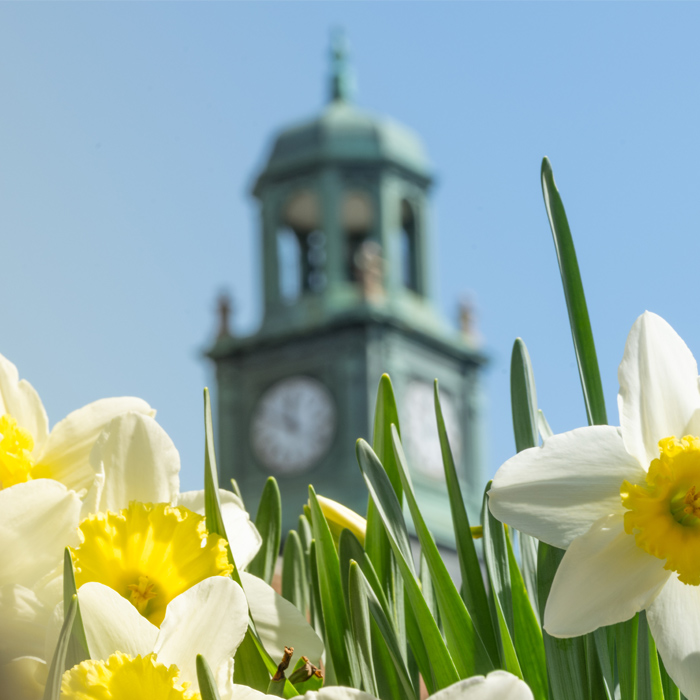Ask the Experts
Campus Sustainability
Find answers to burning questions about waste, renewable energy, more on campus
We asked students, staff and faculty to share questions they had about sustainability at TU. From food waste to solar panels, and plenty of questions in between, experts on campus are providing some answers.
Where does recycling, trash and compost go after we dispose of it? What’s the process like?
Manager of Facilities Support Services, Tracie Rusnak: TU’s mixed recycling goes to a materials recovery facility (MRF) to be sorted, cleaned and processed by machine and by hand. Separated materials are baled for sale to manufacturers to turn into new products. Our mixed metals, construction waste and wood waste go to separate facilities to sort, process and recycle as appropriate.
Trash is transported to transfer stations and then on to waste landfills. The process of landfilling waste is complex, and landfill sites are carefully engineered to isolate waste from the surrounding environment while collecting fluids and gases for treatment and processing. TU works to divert our waste away from incinerators whenever possible due to added environmental concerns.
Compostable waste, including food waste and compostable packaging, is picked up by a company that delivers it to the Western Branch Composting Facility in Prince George’s County, Maryland. The material is turned into compost for soil enrichment, gardening and agriculture.
What do you recommend for upcycling items on campus, like merchandise, posters, etc.?
Director of Sustainability, Patricia Watson: Before purchasing, consider input from the Office of Procurement, the Department of Trademark and Licensing and the Office of Sustainability to help you consider why you are purchasing items, how long they will be used and how the items can be responsibly managed when they are no longer needed. This will help you plan for potential upcycling needs and also connect you with licensed vendors. Also, keep in mind the Maryland Green Purchasing specifications to provide environmental guidelines for purchasing everything from paint and utilities and swag and merchandise.
What renewable sources of energy does the campus use?
Energy Analyst Coordinator, Ghadir Sara: Towson University has 4,000 solar panels on the rooftops of Barton and Douglass houses, General Services, the University Union and the Union Parking Garage. These panels provide nearly 1.5 megawatt hours of solar energy per year to the buildings they’re on. Also, through three power purchase agreements (PPA), TU purchases 100% renewable electricity in the forms of solar and wind, and 52% of the campus’ energy load is renewable.
What does TU do to prevent food waste?
Tiger Hospitality Registered Dietitian, Holly Delagrange: Tiger Hospitality is committed to eliminating waste before it's created. They drive waste minimization by following food management practices and reducing, reusing and recycling food waste wherever possible.
In the event of food waste, all inedible food from the residential dining halls is composted, and the innovative OSCAR Sort system helps guide students in properly disposing of their food waste in retail settings. This initiative significantly reduces the amount of food that ends up in landfills, contributing to a greener campus.
One of the standout initiatives in reducing food waste is Tiger Hospitality’s partnership with the Food Recovery Network. They donate all leftover edible food to Towson University’s chapter, which redistributes it to those in need within the TU community. This not only helps feed individuals who are food insecure but also significantly reduces the amount of food waste generated on campus.
In addition to donations, Tiger Hospitality takes a proactive approach to understanding and mitigating food waste through their monthly Weigh the Waste events. During these sessions, they collect food waste from guests in the dining hall to analyze the volume of food being discarded and uncover the reasons behind it. This valuable data allows Tiger Hospitality to make informed adjustments to their operations, preventing food waste before it even occurs.
What does having LEED-certified buildings mean? How many LEED-certified buildings are on campus, and which ones are they?
Director of Design and Constructive Services, David Mayhew: As a benchmark for the sustainability of campus buildings, Leadership in Energy and Environmental Design, or LEED, provides a framework for identifying and implementing measurable green building design, construction, operations and maintenance solutions. The buildings contain high-performance HVAC systems, water-efficient fixtures, recycling areas, environmentally sensitive landscaping, bike racks and other sustainable features such as green roofs.
The campus currently boasts 15 LEED-certified buildings: TU Arena, the West Village Commons building, Marshall and Barnes halls, Burdick, Residence Tower, Barton and Douglass houses, Public Safety, College of Liberal Arts, Science Complex, University Union, Glen Dining, Health Professions Building and Health and Counseling Services. Of these, nine are registered as LEED Gold including the new Health Professions Building, and six are LEED Silver. Once completed in early 2027, Smith Hall will also be registered as LEED Gold.
